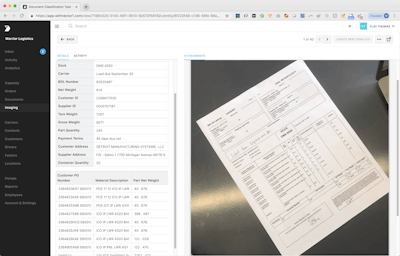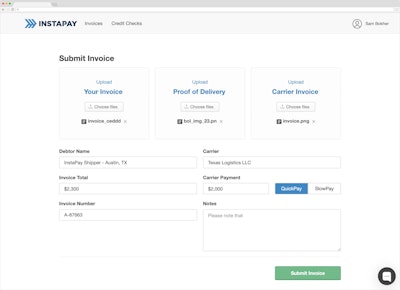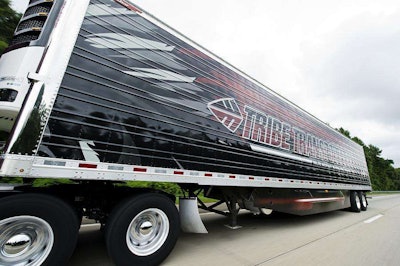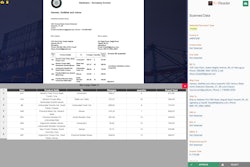 Vector’s mobile app has a back office system that can instantly read and transcribe information from printed documents and handwritten notes.
Vector’s mobile app has a back office system that can instantly read and transcribe information from printed documents and handwritten notes.Cash flow is the lifeblood of any business, especially motor carriers who must cover their fuel, payroll and other operating expenses long before shippers and brokers pay freight bills.
“If you don’t mind waiting, you can get paid in 30 days, but as a small trucking company we need it quicker,” says Lexi Howard, manager of Buffalo Trucking, a five-truck refrigerated and dry-van fleet based in Memphis, Mo.
Fleets like Buffalo Trucking that operate five trucks or less make up 86 percent of Federal Motor Carrier Safety Administration registrants. As the bedrock of trucking capacity, small fleets generally need access to working capital within a few days of completing a load to keep their wheels turning.
Carriers of all sizes are using technology to speed their billing cycles.
When Tribe Transportation implemented a document scanning app from Vector in November 2017, the results were immediately clear.
“The image quality is amazing,” says Todd Gooch, vice president of Tribe, a transporter of high-end, high-security pharmaceuticals, fresh foods and other fragile cargo. “The reliability is 100% better than what we were getting with the old scanners we used.”
Tribe previously used portable scanners that plugged into an onboard communications system. Since converting to the Vector app, Tribe has seen a seven-day decrease in days sales outstanding (DSO) or accounts receivable, Gooch says. Driver communications and payroll processes also improved.
“We’re able to get our bills of lading in, we’re able to invoice quicker, which speeds up our cash flow,” he says. “That’s really the game changer for us.”
 Carriers and brokers use the InstaPay web portal to upload their invoices for same-day payment.
Carriers and brokers use the InstaPay web portal to upload their invoices for same-day payment.The Gainsville, Ga.-based carrier is growing its fleet from 400 to 500 trucks, but has not grown its staff of five payment and accounting staffers.
Technology has also helped factoring become more of a viable option for fleets to receive same- and next-day access to funds while increasing back-office efficiencies. Below are three common myths of factoring that have been dispelled by modern solutions.
Myth 1: My 3% rate is 36% APR
Some factoring companies that specialize in transportation have recently developed technology that streamlines transactions to lower the costs and risks of funding.
Fee structures are now as low as 3% of the invoice amounts. Rates for factoring with recourse — an arrangement where the carrier buys back the receivables that a factor does not collect payment on — may be even lower.
Going for a lower rate may not protect the carrier from the insolvency risks of their customers.
Even so, a 3% fee for non-recourse factoring may appear too expensive to gain access to funds for invoices with 30-day payment terms. After all, financing a 30-day invoice at 3% would be equal to a 36% annualized rate. Not exactly.
In practice, freight bills with 30-day payment terms are typically paid out in 35 to 40 days from sending the invoice. Tack on another 5 days to receive the payment by paper check, and the APR of a 3% factoring fee is closer to 24% (3%*360/45).
Furthermore, APRs heavily depend on volume and term. Short-term rates will always be higher than long-term interest rates. For instance, a credit card (~18%) that has a 30-day billing cycle is higher than a bank line of credit (~9-13%) or a mortgage (~5%).
Factoring is not just about speeding cash flow. For a 3% fee, a factor includes back-office services and insurance that saves carriers time and money. The factor takes over invoicing, collections and protects the carrier from insolvency of its shipper or broker customers.
Including these services in the fee helps carriers focus their resources on finding better loads and negotiating higher freight rates, for example.
 Tribe Transportation began using a document scanning app from Vector in Nov. 2017
Tribe Transportation began using a document scanning app from Vector in Nov. 2017“To be fair, factoring doesn’t make sense to everyone,” explains Sam Bokher, director of operations for InstaPay, a factoring company that provides carriers with financing alternatives to grow their businesses. “For example, large fleets with a high volume of shipments can more easily obtain debt financing, if needed, and run their back-office functions more efficiently in-house but smaller fleets don’t have those advantages.”
Myth 2: Factoring is all-or-nothing
Factoring companies have traditionally required monthly volume commitments from carriers. This model has changed now that some companies allow carriers to select which customers and invoices they want to factor.
To choose which loads to factor, a carrier is able to print and scan a select group of freight bills from its accounting system, or scan the load paperwork directly using its vendor’s mobile app.
Once the documents are uploaded to the factoring company, the carrier receives electronic payment in their bank accounts on the same or next day, depending on the time of day the transaction was completed.
Buffalo Trucking has been factoring select invoices with InstaPay for about one year. “The online process is awesome,” she says. “I love everything about it and would definitely recommend.”
Myth 3: My factor will lock me into a contract
This may not be a myth. Most factoring companies actually want to lock carriers into a contract for a certain volume of invoices over a specified time period.
Requiring a term commitment helps the factor cover its costs for underwriting and acquiring new customers. Even so, some companies do not require term commitments and instead allow their clients the flexibility to stop at any time as their business needs and preferences change.
Another distinguishing feature of some factoring companies is no hidden charges. Setting up new customers, electronic fund transfers and other transactions are included as part of a vendor’s flat fee.
Factoring has traditionally been viewed as a last resort for carriers to quickly access working capital. New services are available with low fees and no hidden costs that enable carriers to use factoring where and when it makes sense to profitably grow their businesses.












